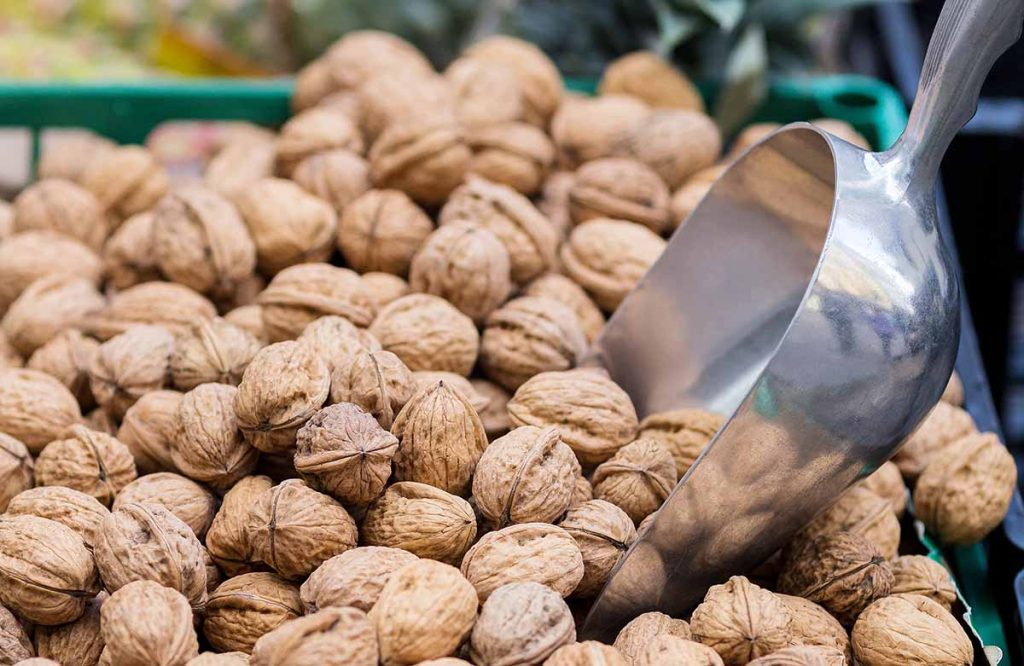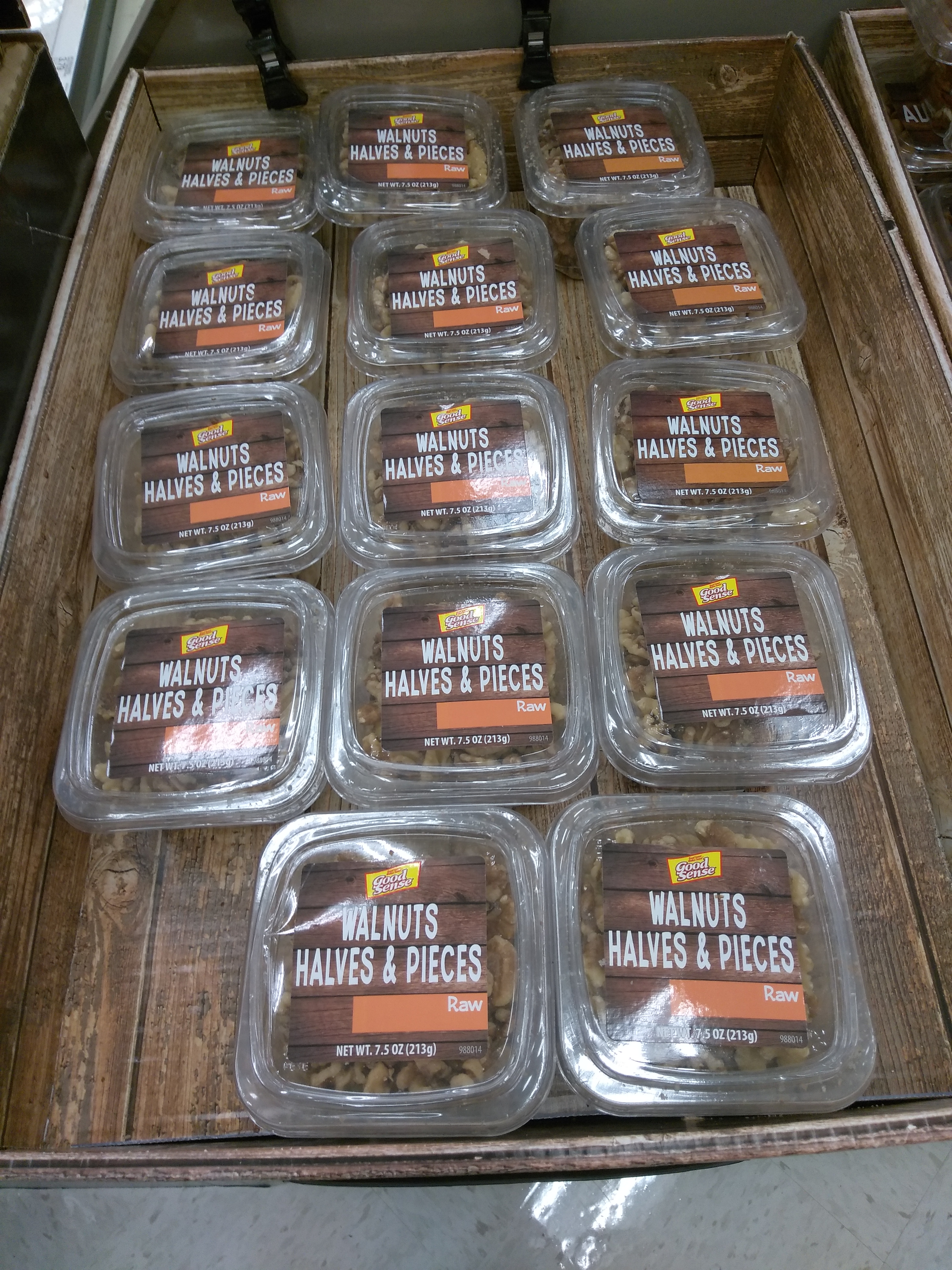Healthy Attributes Give Walnuts Value Beyond Holidays
July 17, 2019 | 6 min to read
Walnut sales are on the rise, driven by health trends and the shift towards plant-based diets. Retailers report double-digit growth, particularly during holidays, while promotions can boost sales year-round. The California Walnut Board emphasizes visibility in stores and highlights walnuts' unique health benefits, including being the only nut rich in plant-based omega-3 ALA. Innovative packaging and value-added products, such as glazed varieties, are gaining popularity, creating more opportunities for retailers to cater to health-conscious snacking preferences.

With near-zero shrink and limitless benefits, these nuts have sales potential all year.
The benefits of marketing and merchandising walnuts in the produce department are many and easily accomplished with a bit of effort.
High-quality nuts, value-added varieties, different sizes, innovative packaging, timely promotions and savvy sales pitches can combine to make walnut displays a destination location within the department.
Walnut sales in produce are growing, according to the California Walnut Board and Commission, Folsom, CA, reflecting both the interest in more healthful food choices — especially plant-based eating — and the fact that snacking now accounts for 50% of all eating occasions.
Many of the retailers the California Walnut Board works with report being pleased with double-digit annual sales growth, especially since walnuts are one of the rare produce items with near-zero shrink.
Walnuts are often merchandised with other nut varieties in a “nut center” in the produce department, which is an effective arrangement for shoppers.
The key to maximizing sales in produce, says Jennifer Olmstead, marketing director, domestic public relations for the Board, is to “make certain that the nut section is visible and easy to shop, versus being placed in the back of the department or on the bottom shelves below croutons.”
Walnut sales still peak during the November-to-December holidays, followed by Easter. “However, the experience we’ve had with our produce promotion programs is walnuts can deliver strong sales during any month of the year,” says Olmstead.
For example, she says, “We just finished up a wave of produce promotions in February and had one retailer report an 82% gain in unit sales. Another recorded a 96% increase in units sold, and a third chain, with more than 1,000 units, shared that they sold more walnuts in February than they had sold during the previous December.”
PURCHASE FACTORS
 A strategy for improving walnut sales in the produce department must take into account a variety of factors that cause consumers to make their purchases. These factors include:
A strategy for improving walnut sales in the produce department must take into account a variety of factors that cause consumers to make their purchases. These factors include:
Health: Retailers can always benefit by emphasizing the freshness of the walnuts, with packaging that mimics the fruits and vegetables sold in their departments. “At the same time,” Olmstead points out, “given that snacking has become the No. 1 use for walnuts, packaging should be re-closeable or resealable.”
Mark Calder, who handles export sales at Primavera Marketing Inc. in Linden, CA, similarly prescribes visibility. “Consumers are trending to healthier snacks/ingredients, yet walnuts for the most part remain isolated within the aisles.” Globally, he adds, consumption is on the rise, “mainly due to health benefits and marketing awareness. Walnuts are the healthiest nut you can buy.”
Olmstead cites the health factor, as well.
“The short answer is that this [health] trend has everything to do with the growth of walnut sales in produce,” says Olmstead. “However, while the vast majority of shoppers — 92% — understand that walnuts are healthy, many shoppers do not understand specific benefits of walnuts. For instance, walnuts are the only nut that are an excellent source of plant-based omega-3 ALA (alpha-linolenic acid), at 2.5 grams per ounce.”
Salad toppers, baking and snacking are the largest occasions. “However,” says Calder, “snacking is a category where we are looking to increase exposure in the coming years.”
Chad Hartman, executive director of sales and marketing for Tropical Foods in Charlotte, NC, likewise notes a health correlation.
“From what we are seeing, as healthy nuts go, walnuts go,” he says. “Walnuts have many very healthy attributes, so the move toward healthier foods has definitely helped walnut sales. We have seen a spike recently, and costs have gone down and availability up.”
Varieties: The industry is slowly expanding the category of brand extensions, such as honey-coated.
There is an enormous opportunity at retail for seasoned and flavored walnuts, the Board has found, given the growing interest in snacking on walnuts and the success that other nut varieties have had with sweet and savory coatings. Says Olmstead, “There has definitely been an increase in the number of glazed walnuts being introduced, which makes these walnuts an appealing snack choice.”
The value-added walnut items generating the most buzz are glazed walnuts or blends with dried fruit and/or other nuts, such as an “omega mix” product that is among many retailers’ best sellers. There have also been nut-butter products introduced from brands such as Crazy Go Nuts and Nutty Gourmet. All of these value-added items appear to be doing well, but when one looks at what other nut varieties are offering, it is clear there is an opportunity for more.
Sizes: Olmstead calls it unfortunate that many retailers only offer a single size of walnuts in their produce departments. “We’ve seen the most successful retailers stocking sizes between 10 to 16 ounces.”
For snacking, halves, the largest size, are best, says Calder. “For ingredient, any size will suit.” Smaller packages also are becoming more available.
Halves or halves with pieces sell the best, agrees Hartman. “We are also seeing an increase in light product, as opposed to combination product.”
Packaging: There has been a pronounced shift to resealable, standup walnut packaging in the grocery aisles, and this is beginning to show up in produce, as well. “We’ve also seen a few new ‘canister’ introductions taking aim on the snacking opportunity,” notes Olmstead.
Promotions: The Board advises retailers to promote walnuts more frequently to increase awareness of walnuts stocked in the produce department and mention walnuts’ health benefits and versatility through in-store signage as well as digital communications.
“In addition, one of the easiest things retailers can do to increase walnut sales in the produce department is to contact the California Walnut Board,” notes Olmstead. “We have an entire program focused on growing walnut sales in this area of the store, with the ability to contribute resources to increase purchase intent and drive incremental sales volume.”
Merchandising: Walnuts are more of a baking nut than a snacking nut, says Hartman, “so for the most part they should not be merchandised with other snack nuts in the produce department, but with baking nuts.”
For example, placing walnuts on a display with pecans is a good fit, he says. “Recently, walnuts have been tied to many healthy attributes, such as omega-3s, so keeping them in a high-traffic area where consumers can find them and choose their own application is a must.”
Hartman’s recipe for retailers who want to sell more walnuts in the produce department is threefold:
- Display them in a visible area with like items, such as pecans.
- Display them with other salad toppings.
- Use temporary price reductions during peak season.
“Year-round visibility” will get the job done, says Calder. “In addition, display both ingredient and snacking-size packages/sizes. All are available industrywide.”
Seasonality: The best times of year for walnut sales are no surprise: holidays, baking season and New Year’s, when we see sales bumps because they are used more often as salad toppers.
Recipes: Walnuts continue to demonstrate their versatility by being included in recipes, ranging from salads to side dishes and from baked goods to smoothies. In recent months, the California Walnut Board has responded to retailers’ requests by creating almost two dozen new recipes combining walnuts with other produce items such as strawberries, blueberries, apples, pears, cherries and avocados.
“We’ve also partnered with a number of commodity boards as well as produce brands to cross promote their recipes and include them on walnuts.org,” says Olmstead. “And we’ve created videos for many of these new recipes, which retailers are able to utilize in their digital and social channels.”
What Hartman calls the “new” recipe is using walnuts as salad toppers. “It is a constant challenge with salad eaters to find that topper that keeps the salad healthy, but also adds a little flavor and texture. Walnuts fit the bill. Walnuts have always been a baking nut, and providing walnut costs remain on the low side, they will continue to be used extensively in baked goods. For snacking there are opportunities, but leading with them as a salad topper or a baking nut would be better.”
Building sales of walnuts out of the produce department can be done without great difficulty. It simply behooves retailers to choose the best marketing tactics to accomplish that goal.
Hand-Harvested Black Walnuts Selling Well
 Black walnuts, which are hand-harvested and sourced from wild trees in the Midwest, are experiencing significant sales growth at retail. The nuts possess a bold and distinct flavor.
Black walnuts, which are hand-harvested and sourced from wild trees in the Midwest, are experiencing significant sales growth at retail. The nuts possess a bold and distinct flavor.
Since 2017, Hammons Products Co., Stockton, MO, has been selling record volumes of its retail packages, which it redesigned last fall. The new packaging pays tribute to the thousands of Midwestern gatherers by showcasing the story of harvesting sustainability, health benefits and the nut’s bold flavor.
“The flavor is certainly one of the key features,” says Jacob Basecke, vice president of sales and marketing. “A lot of people appreciate the distinct flavor profile of black walnuts and how they complement a wide range of flavors. With the growing demand for plant proteins and black walnuts having the highest protein of all nuts, we’ve been able to reach a lot of new consumers and make a significant impact in overall consumption.”
13 of 17 article in Produce Business July 2019

